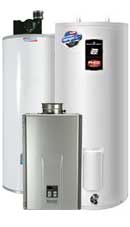 Hot water is something most of us take for granted … until there’s no more hot water on that morning when it’s cold and you’re running late. Thankfully, it doesn’t happen often because the systems we use these days are reliable and can operate for years without a problem.
Hot water is something most of us take for granted … until there’s no more hot water on that morning when it’s cold and you’re running late. Thankfully, it doesn’t happen often because the systems we use these days are reliable and can operate for years without a problem.
But when a problem does occur, it’s a good idea to know how things work even if you’re not going to make the repairs yourself.
Most Canadian homes still have a tank-style water heater. These systems use a large, cylindrical tank that stands on one end and have pipes coming out of it. If you don’t have a tank, your home uses a tankless system.
The standard water heater (tank-style) can be electric or fuel. If your system uses fuel it probably uses either gas or oil. These units have a vent pipe at the top that removes the exhaust. Electric models do not need to vent; they simply have a power cable to plug in for them to run. The job of the tank-type heater is not only to heat the water, but also to store it until it’s ready for use. So, in addition to the tank’s heating system, every tank is equipped with insulation to help keep the water warm between heating cycles.
You’ll find the water supply and delivery pipes on top of each unit. The supply pipe sends cold water to the bottom of the tank and the delivery pipe sends hot water from the top to your running tap.
Each unit is equipped with a temperature and pressure relief valve for safety. This valve opens if either the temperature or pressure exceeds the predetermined safe limit. It is connected to a pipe that runs down the exterior of the tank. It’s not a bad idea to keep a bucket or some other receptacle under the end of the valve just in case it ever opens. If you ever find anything in the bucket, then it’s usually a sign that there’s a problem and you should call a professional immediately.
Corrosion is the primary reason tank systems fail. Once a rust hole appears, you need to have your tank replaced. There are temporary fixes but they should be used only until you have a professional arrive. All tanks have an anode rod to control corrosion. The magnesium anode rod protects the tank by corroding in place of the steel. Because the rod is designed to corrode, it will eventually wear away. After this happens, corrosion of the steel accelerates. It’s a good idea to check the anode rod once a year, and replace it if necessary. At the bottom of every tank is a drain cock to empty the heater, and a valve on the supply pipe allows you to shut down the cold-water feed line without affecting the water supply to the house.
Each type of system works differently and has different parts. This article is the first of a two part series specifically about water heaters. In part two we will go through each type in detail.
